Tui birdsong borrowed from Accommodation in NZ
BadAssBees Index
|
Some Critters |
||||
|
Click the thumbnails for a larger picture. This page operates ONE slave window. |
||||
I'll start with another bird photo - the Tui.
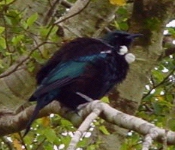 These apparently black and white song-birds are darkly iridescent with blue purple and green in the right light (although capturing restless birds is not the strongpoint of my slow camera - apologies for the poor photo) and are still abundantly common throughout NZ, even in suburban areas. NZ's many species of melodic songbirds make for a very musical bush experience - in stark contrast to the Australian wildlife, which foreigners often assume to be similar. Tui have a very wide range of calls, with many clear 'bell' sounds (near impossible to distinguish from the bellbird, also very common in the bush - bellbird call
here), right through to harsh croaks and gracks. They are also good mimics, and in areas with many bellbirds its only the more frequent 'grack' which gives the Tui away.
These apparently black and white song-birds are darkly iridescent with blue purple and green in the right light (although capturing restless birds is not the strongpoint of my slow camera - apologies for the poor photo) and are still abundantly common throughout NZ, even in suburban areas. NZ's many species of melodic songbirds make for a very musical bush experience - in stark contrast to the Australian wildlife, which foreigners often assume to be similar. Tui have a very wide range of calls, with many clear 'bell' sounds (near impossible to distinguish from the bellbird, also very common in the bush - bellbird call
here), right through to harsh croaks and gracks. They are also good mimics, and in areas with many bellbirds its only the more frequent 'grack' which gives the Tui away. |
||||
It's well known i keep bees.
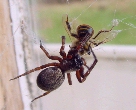 Some say i keep spiders too, as i permit them to live around
Some say i keep spiders too, as i permit them to live around
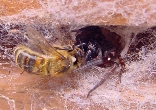 my windows for the great job they do reducing the levels of annoying flies and mosquitos in my hut. Sometimes however its not flies or mosquitos that the spiders are taking care of for me...
my windows for the great job they do reducing the levels of annoying flies and mosquitos in my hut. Sometimes however its not flies or mosquitos that the spiders are taking care of for me... |
||||
Although 'the coast' is known for its mild wet climate, Mt Elliot is quite far inland
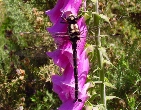 (by New Zealand standards) and in summer it can get quite hot here - i've often recorded over 28 degrees C in the shade (only for the nearest TV weather location to record barely 22 degrees down by the sea), and over
(by New Zealand standards) and in summer it can get quite hot here - i've often recorded over 28 degrees C in the shade (only for the nearest TV weather location to record barely 22 degrees down by the sea), and over
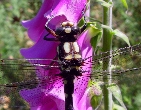 35 deg C in the sun. And of course all sorts of bugs like it hot - especially the bigger ones. Here're a couple of snaps of one of those bigger bugs, a dragonfly basking on a foxglove in the mid-summer sun. Unfortunately he wouldn't let me get too close, relocating when i tried to hold my hand in the frame for scale - around 10cm+.
35 deg C in the sun. And of course all sorts of bugs like it hot - especially the bigger ones. Here're a couple of snaps of one of those bigger bugs, a dragonfly basking on a foxglove in the mid-summer sun. Unfortunately he wouldn't let me get too close, relocating when i tried to hold my hand in the frame for scale - around 10cm+. |
||||
|
Aside from the birds and the bees (and other assorted bugs) there are also some 'domesticated' animals on Elliot's Toe.
Stinky my old dog is under the ground now, her 15 years of trouble-free motoring finally came to an end in January. She came into my life when i was doing volunteer work for the SPCA Animal Refuge in Waihi. I don't know her previous history of course, but she never overcame her 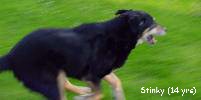 cowering fear of strangers, especially men - though she would put up a bold noisy facade if she had an avenue of escape. cowering fear of strangers, especially men - though she would put up a bold noisy facade if she had an avenue of escape.
But Stinky came alive when i went cycling, a completely different pup, she knew no speed but mad flat-out with a joyous carefree grin until her battery ran down from fatigue. She also enjoyed tramping (hiking) out in the mountains for days with no people around except the ones she trusted. In her final year she just slept all the time - rousing herself excitedly and hopping up and down like a puppy when it was time to go cycling... for 5 minutes, then she was spent, and content to collapse again 'til the next day. We went some places Stinky - i miss you the most. 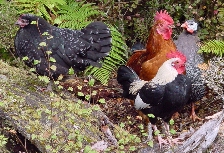
And my feathered companions also have gone, on account of a rare New Zealand native falcon (see my karearea page). Over summer 2003/2004 Elliot's Toe enjoyed the company of Brutus & Co, a Highland bull and his 2 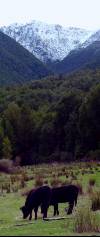 paddock-mates i borrowed to 'service' ChocolateMousse & ChocolateCake, my 2 semi-tame half-highland heifers. Brutus was a real sweetie, very placid and hairy, he would happily enjoy being scratched in the hard-to-reach spot behind the base of his horns,
paddock-mates i borrowed to 'service' ChocolateMousse & ChocolateCake, my 2 semi-tame half-highland heifers. Brutus was a real sweetie, very placid and hairy, he would happily enjoy being scratched in the hard-to-reach spot behind the base of his horns,
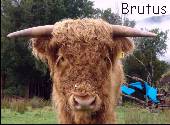 though with horns like his, one had to be careful when he had enough and would swing his head away.
though with horns like his, one had to be careful when he had enough and would swing his head away.
His 2 imported paddock-mates were less adorable, being flighty and headstrong, they were difficult to manage. I respect that, and would probably be the same if i were bovine, but from my current viewpoint they were just a pain in the ass! ChocolateMousse (one of my heifers) and Brutus became great mates and spent all their time together (i wonder whether Brutus left her side long enough to 'service' anyone else? Will find out in Spring...), but unfortunately because Brutus was only on loan then i had to split the happy couple recently to send him and his 2 mates back home. I'll miss Brutus, but not so much as ChocolateMousse does... Some friends had to move house, and couldn't take their two pet Romney (?) sheep with them to  their new digs. So Thomas and Weenie came to stay with me, and i get many chuckles from them -
their new digs. So Thomas and Weenie came to stay with me, and i get many chuckles from them -
 although sometimes they exasperate too, when they try to bring their un-housetrained-selves onto the 'deck', or worse, right inside.
although sometimes they exasperate too, when they try to bring their un-housetrained-selves onto the 'deck', or worse, right inside.
As ex-pets they really didn't know what to make of my other sheep - which was also true in reverse. At their first meeting some of my sheep tentatively approached, but when they got too near Weenie started butting and Thomas followed suit, scattering the locals. Over time things have normalised and now they run with the others, moving away with them as i approach - unless i have snacks to bribe them... |
||||

|
||||
Arapawa SheepIt wouldn't be rural New Zealand without a flock of sheep. There was a time when there were 30 sheep for every person in NZ, and while changing economies have reduced that figure (around 20:1 now) NZ is still renowned for its sheep farming. Without any grazing animals, my patch was quickly disappearing under (more) gorse, blackberry and bracken, so i needed some organic lawnmowers, and acquired some Arapawa sheep.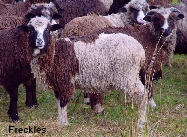 Even at a casual glance you can see that Arapawas are not your typical sheep. I wanted something that was hardy, with few health problems and low maintenance.
Even at a casual glance you can see that Arapawas are not your typical sheep. I wanted something that was hardy, with few health problems and low maintenance.Arapawa sheep are descended from the a mix of merinos which were farmed on Arapawa island in the 1800's, and possibly 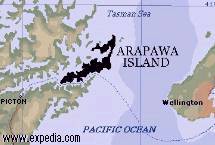 some uncommon scottish and bengal breeds that were landed there previously in the days of the old whaling stations. Commercial sheep farming was abandoned on the island in the late 1800's, and the bloodlines were then mixed and mingled according to natural selection for over 100 years. some uncommon scottish and bengal breeds that were landed there previously in the days of the old whaling stations. Commercial sheep farming was abandoned on the island in the late 1800's, and the bloodlines were then mixed and mingled according to natural selection for over 100 years. Any individuals susceptible to fly-strike, parasites, footrot etc didn't survive, and their genes were removed from the mix.
Any individuals susceptible to fly-strike, parasites, footrot etc didn't survive, and their genes were removed from the mix. The end result today is a small hardy sheep, strongly horned on the rams and frequently the ewes as well to a lesser degree, resistant to most common problems, which is not fussy about food and sheds its fleece if it is not shorn. The fleece is perhaps the most obvious difference, ranging 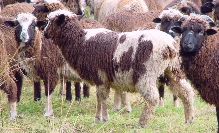 from black to white, with some individuals having striking pied markings, like the famous "Jacob sheep". Many of the old scottish breeds had superfine wool, and many Arapawa today still have finer wool than merino (merino is considered the finest-wool commercial breed). from black to white, with some individuals having striking pied markings, like the famous "Jacob sheep". Many of the old scottish breeds had superfine wool, and many Arapawa today still have finer wool than merino (merino is considered the finest-wool commercial breed).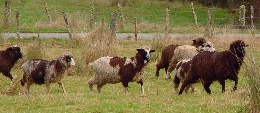 Their 100 years of natural selection came to an abrupt and brutal end when the NZ Department of "Conservation" decided to remove all non-native animals from Arapawa island, and true to their usual genocidal tendancies they set about achieving this by attempting to shoot every last sheep, goat and pig, despite many folk offering to take the animals live, and depite the potential contained in their rare, hardy genes. Precious few were saved from DOC's ideological extermination, and now the NZ rare breeds association has established
Their 100 years of natural selection came to an abrupt and brutal end when the NZ Department of "Conservation" decided to remove all non-native animals from Arapawa island, and true to their usual genocidal tendancies they set about achieving this by attempting to shoot every last sheep, goat and pig, despite many folk offering to take the animals live, and depite the potential contained in their rare, hardy genes. Precious few were saved from DOC's ideological extermination, and now the NZ rare breeds association has established
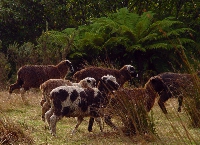 a few breeding flocks and is encouraging more folk to help preserve this distinctly NZ breed. Scientists too have recognised the desirable traits Arapawas have, and are investigating breeding their disease-resistance into commercial breeds. a few breeding flocks and is encouraging more folk to help preserve this distinctly NZ breed. Scientists too have recognised the desirable traits Arapawas have, and are investigating breeding their disease-resistance into commercial breeds. Having been wild for so many generations they are now also a somewhat wary breed - those which didn't run away at the sight of humans were the first to get shot - and they like to keep a generous distance from me whenever i approach. 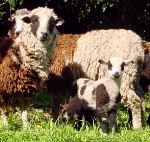 Gimme time - i'll bring them 'round. They say that "music soothes the savage beast", but i know that FOOD wins them over in the end...
Gimme time - i'll bring them 'round. They say that "music soothes the savage beast", but i know that FOOD wins them over in the end...I now have enough lawnmowers but the magic of life keeps on producing more... Email me if you have grazing room and would like to acquire for yourself some hardy, low-maintenance unusual sheep that are more kiwi than the Lord Of The Rings. For more information on Arapawa Sheep and other rare breeds visit www.rarebreeds.co.nz "Our task must be to free ourselves... by widening our circle of compassion to embrace all living creatures and the whole of nature and its beauty." - Albert Einstein "If one person is unkind to an animal it is considered to be cruelty, but where a lot of people are unkind to animals, especially in the name of commerce, the cruelty is condoned and, once large sums of money are at stake, will be defended to the last by otherwise intelligent people." - Ruth Harrison |
||||
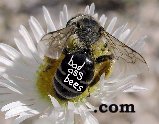 BadAssBees Index |
||||
|
Cursor following bees swiped from Jeff Davies site: Beekeeping the Natural Way using Oils and Herbs |
||||
Email Me
Since 10/7/3